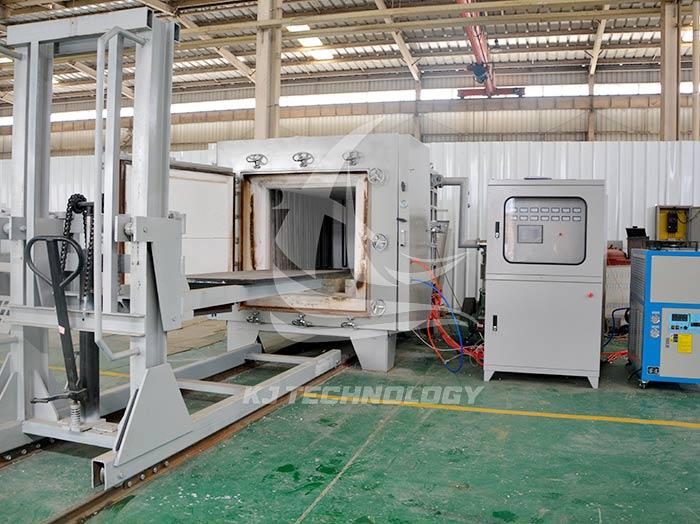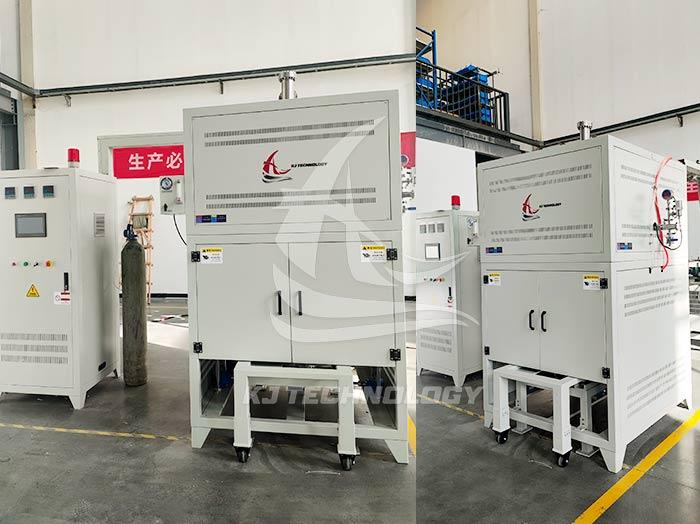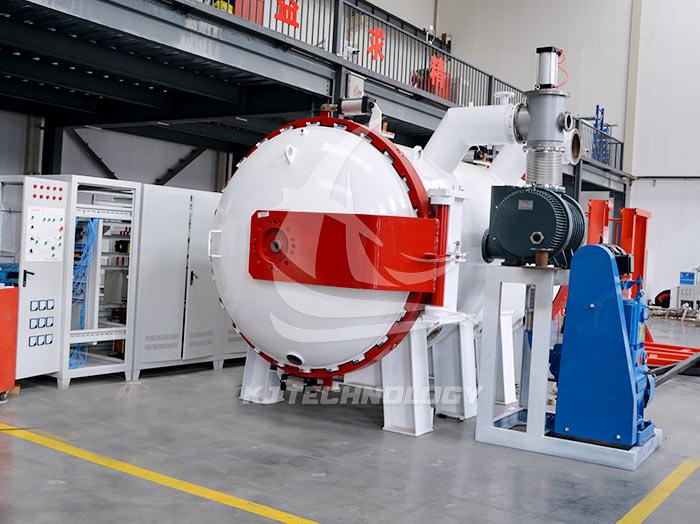What is the working principle of a vacuum hot press furnace?
 07-07-2025 Author: KJ technology
07-07-2025 Author: KJ technology
A vacuum hot press furnace is a precision equipment that integrates high-temperature heating and mechanical pressure. Its core principle is to eliminate the risk of material oxidation through a vacuum environment, while utilizing high-temperature softening of material particles and promoting metallurgical bonding between particles through mechanical pressure, ultimately achieving material densification sintering or hot press forming.
1. Core working principle: synergistic effect of three elements
Vacuum environment
Function: By using a vacuum system to pump the pressure inside the furnace to extremely low levels (usually ≤ 10 ⁻ ³ Pa), the concentration of active gases such as oxygen and nitrogen is significantly reduced, preventing materials from undergoing oxidation, decarburization, or nitriding reactions at high temperatures.
Typical scenario: When sintering titanium alloys, the vacuum environment can control the oxygen content to ≤ 0.01%, significantly improving the fatigue life of the material.
High temperature heating
Heating method:
Resistance heating: using heating elements such as graphite and molybdenum wire to generate Joule heat through current, with a temperature range of up to 800-2000 ℃.
Induction heating: Using the principle of electromagnetic induction to generate eddy currents inside metal workpieces, achieving rapid heating (applicable to metal materials).
Temperature control: Real time monitoring of furnace temperature through thermocouples (such as K-type and S-type) and feedback to temperature controllers (such as PID controllers) to achieve precise control of temperature accuracy ± 1 ℃ and uniformity ± 5 ℃.
Mechanical pressurization
Pressure source: The hydraulic system drives the pressure head (unidirectional or bidirectional pressurization) to apply pressure to the material, typically ranging from 10-100 tons (adjustable).
Pressure transmission: Pressure is uniformly transmitted to the surface of the material through the mold, promoting particle rearrangement, plastic deformation, and diffusion bonding, eliminating pores, and increasing density (up to 99.5% or more).
2. Staged workflow
Loading and Vacuum Extraction Stage
Operation: Place the materials to be processed (such as powder compacts, ceramic bodies) into graphite or metal molds, close the furnace door, and start the vacuum system.
Vacuum process:
Mechanical pump rough pumping: Reduce the pressure inside the furnace to 10 ³ -10 Pa.
Roots pump suction: further reduce the pressure to 10 ⁻¹ -10 ⁻ ² Pa.
Oil diffusion pump high pumping: ultimately reaching the ultimate vacuum degree of ≤ 10 ⁻ ³ Pa.
Key point: During the vacuum pumping process, continuous monitoring of the vacuum degree is required. If the pressure rises abnormally (such as leakage), the machine should be stopped immediately for inspection.
Heating and insulation stage
Heating rate: Set according to material characteristics (such as ceramic ≤ 10 ℃/min, metal ≤ 20 ℃/min) to avoid cracking caused by thermal stress.
Insulation time: Ensure uniform temperature distribution of the material and reach the preset sintering temperature (such as 1400-1450 ℃ insulation for 1-2 hours for hard alloys).
Atmosphere control: If inert gas protection (such as nitrogen or argon) is required, gas can be introduced during the insulation stage, and the pressure is usually controlled at 0.01-0.1 MPa.
Pressure and sintering stage
Timing of pressurization: When the material temperature reaches the sintering temperature, start the hydraulic system to apply pressure.
Pressure curve:
Initial pressurization: Quickly increase the pressure to 50% -70% of the target pressure to promote particle rearrangement.
Pressure holding stage: Maintain a constant pressure (such as 30-60 minutes) to allow sufficient diffusion and binding between particles.
Slow pressure relief: Avoid sudden drops in pressure that can cause stress concentration inside the material.
Typical case: When sintering silicon carbide ceramics, a pressure of 50 MPa needs to be applied at 1800 ℃ and held for 1 hour to achieve a density of 99.8%.
Cooling and material retrieval stage
Cooling method:
Natural cooling: suitable for materials that are insensitive to temperature gradients (such as metals), with a longer cooling time (12-24 hours).
Forced air cooling/water cooling: Accelerated cooling through circulating fans or cooling water (such as ceramic cooling to below 100 ℃ takes 4-8 hours).
Attention to material retrieval: After cooling to ≤ 50 ℃, wear heat-resistant gloves and open the furnace door to avoid high-temperature burns or material oxidation.
3. Key technological advantages
High density and low porosity
Principle: Pressure promotes an increase in the contact area between particles, shortens the diffusion path, and completely fills the pores.
Data: The density of hard alloys sintered in a vacuum hot press furnace can reach 99.5%, while traditional pressureless sintering is only 92% -95%.
Material purity guarantee
Principle: Vacuum environment eliminates gas impurity pollution and avoids the formation of oxide film or nitride.
Case: After hot pressing of aviation titanium alloy blades, the surface oxygen content is ≤ 0.01%, and the fatigue life is increased by 30%.
Ability to form complex shapes
Principle: The pressure is evenly transmitted to the mold, achieving near net forming and reducing subsequent processing volume.
Application: Preparation of silicon nitride ceramic bearing balls (roundness error ≤ 0.5 μ m) and silicon carbide reflectors (surface accuracy λ/20).
Multi material compatibility
Supporting materials: hard alloys, functional ceramics, metal matrix composites, polymer materials, etc.
Process expansion: By adjusting temperature, pressure, and atmosphere parameters, various processes such as sintering, hot pressing, and hot isostatic pressing (HIP) can be achieved.
4. Typical application scenarios
Manufacturing of Hard Alloy Cutting Tools
Process: After mixing tungsten powder and cobalt powder into a compact, it is hot pressed and sintered at 1400-1450 ℃ and 20-30 MPa to produce tool materials with high hardness (HRA ≥ 92) and high wear resistance.
Preparation of Transparent Ceramics
Process: Aluminum oxide (Al ₂ O3) or yttrium aluminum garnet (YAG) powder is hot pressed and sintered at 1600-1800 ℃ and 10-20 MPa, with a transmittance of over 85%. It is used for laser windows, transparent armor, etc.
Carbon fiber reinforced composites
Process: Carbon fiber and resin matrix are hot pressed and cured under high temperature and high pressure to produce high-strength (tensile strength ≥ 2000 MPa) and lightweight (density ≤ 1.8 g/cm ³) structural materials for use in the aerospace industry.








